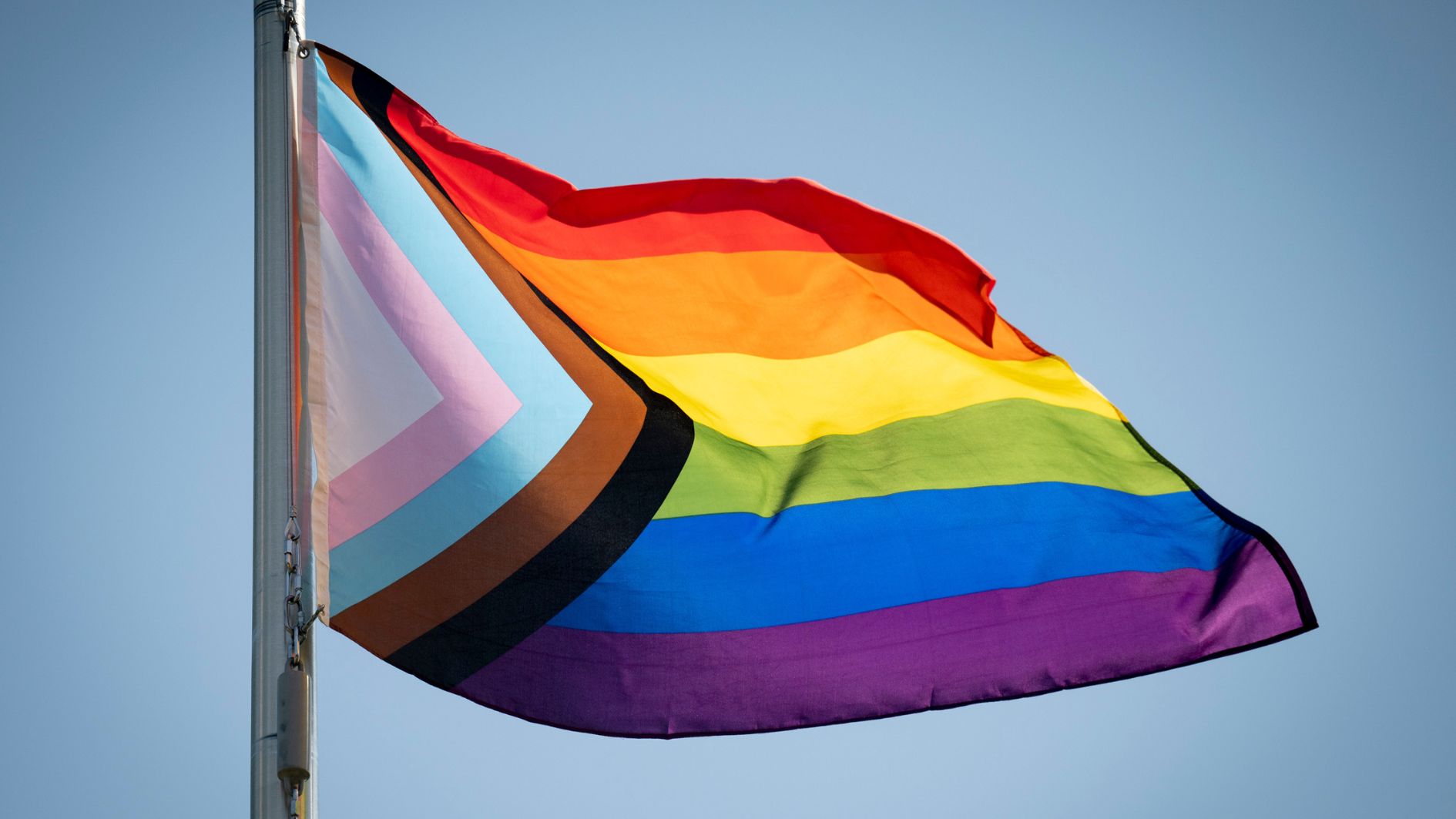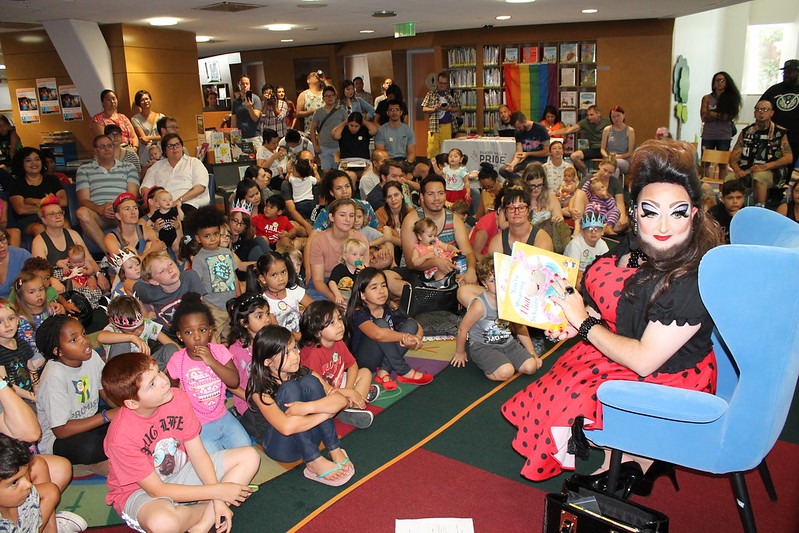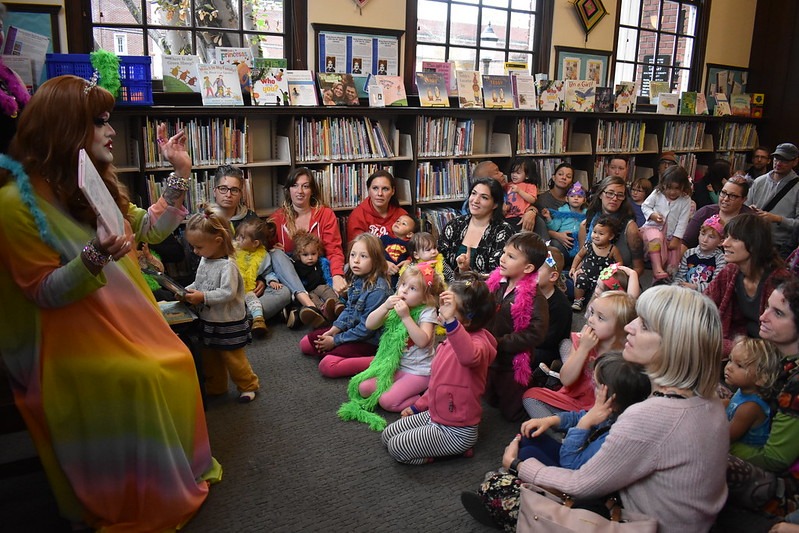Last month drag performers Coco and Erika Flash took Brian Tamaki to court over his protests and public comments against rainbow storytimes which caused them to cancel their storytime tours. Education researcher Kate Morgan writes about the importance of children seeing themselves in books, anti-heteronormative teaching and parenting strategies, and how adults reading to children can do it the Q.U.E.E.R. way.

Flag (verb): To warn or tell people about something that is important or is a problem.
Is “Rainbow Storytime” something that is important, or is it a problem? That, of course, depends on your viewpoint. Throughout March and April 2024 in Aotearoa New Zealand, my attention was caught by several headlines about the obliteration of rainbow street crossings—these actions are now being treated by NZ Police as hate crimes. At the same time there were news stories about the cancellation of various “Rainbow Storytime” sessions around the country. Risks to public safety were cited, amidst death threats to the performers. There was a sad inevitability when in late April I read about the cancellation of the planned nationwide Rainbow Storytime tour scheduled for later in the year, amid “ongoing protest by Destiny Church leader Brian Tamaki.”
Unlike swathes of legislation in Aotearoa New Zealand that have recently been repealed or reversed, these children and families cannot simply be cancelled if they don’t fit in with a government’s philosophy.
What is behind all this hatred and fear? Two Taranaki drag queens (Erika and CoCo Flash) wearing amazing shoes, striking makeup, flamboyant costumes and high-rise hair were publicly sharing picture books with children and their parents/whānau in libraries across the motu/country. More power to them, I say… as this work is part of the rich diversity of our Aotearoa New Zealand culture in the broadest sense. The kaupapa/philosophy of Rainbow Storytime NZ also ties in with the research I did for my Master of Education thesis (2020), focusing on early childhood teachers’ willingness and efficacy in sharing inclusive picture books. One of the things my research found was that to teach intentionally with inclusive picture books requires some preparation and a little bit of courage—things that Erika and CoCo Flash have in spades!
As an education researcher, early childhood teacher, and parent, I have noticed that gender non-conforming/gender diverse children are increasingly part of inclusive early childhood education settings across Aotearoa New Zealand. Similarly, lesbian, gay, bisexual, transgender, intersex and queer (LGBTQI+) parents and staff are more visible than ever in educational spaces—myself included. This takes a certain amount of bravery in a world in which these children and adults will often experience othering or different forms of prejudice. Unlike swathes of legislation in Aotearoa New Zealand that have recently been repealed or reversed, these children and families cannot simply be cancelled if they don’t fit in with a government’s philosophy.

The Aotearoa New Zealand early childhood curriculum document Te Whāriki advocates for the rights of diverse tamariki/children and whānau/families to experience belonging in early childhood education settings. Belonging comes from feeling accepted and approved by your ‘group’ and seeing a reflection of your culture in media such as books, television programmes, and films. In contrast, our national education system has long been steeped in heteronormativity and the heteronormative way of doing things is so taken-for-granted that it is usually invisible. This means anti-heteronormative teaching practices are vital for the inclusive aspirations of Te Whāriki to become a reality. Picture books to the rescue! You don’t even need to don a sumptuous costume or put on high heels in order to begin. You just have to start with something, as Dr Janette Kelly-Ware and I wrote in 2016.
…our national education system has long been steeped in heteronormativity and the heteronormative way of doing things is so taken-for-granted that it is usually invisible.
Anti-heteronormative teaching/parenting strategies deliberately disrupt the (hetero)norm. Examples include encouraging tamariki to play with non-gender-stereotyped toys, changing the gender of characters in songs or stories, and sharing picture books which centre gender diverse or LGBTQI+ characters. These actions help us reflect our diverse society in the experiences of young tamariki, whether that be through picture books, songs, or special events. Susan Briggs wrote in her recent article for The Sapling regarding changes to the New Zealand Year 7-13 English Curriculum, “We have an increasingly diverse population here in Aotearoa, and I enjoy trying to reflect that diversity in the literature I teach.” The very same principle applies in early childhood education too. Rudine Sims Bishop first shared the concept of books as mirrors, windows and sliding glass doors in 1990. As she said in her explanatory article, “When children cannot find themselves reflected in the books they read, or when the images they see are distorted, negative, or laughable, they learn a powerful lesson about how they are devalued in the society of which they are a part.” Jeanie Phillips takes Bishop’s “Mirrors, windows and sliding glass doors” book metaphor and shows us how the concept can be useful at all ages, including adulthood.

When trusted adults share picture books featuring LGBTQI+ families and/or gender diverse children, all children can feel more included and supported in early childhood education settings. Kaiako/teachers sharing inclusive picture books help to expand the early childhood curriculum beyond its traditional limits, reaching for the inclusive aspirations of Te Whāriki and “Our code, our standards.” In the long run, my hope is that this dramatically lessens the chances of these children growing up and wanting to engage in prejudiced behaviour against the ‘rainbow’ part of our community, or even homophobic/transphobic hate crimes such as we saw in March and April this year.
When trusted adults share picture books featuring LGBTQI+ families and/or gender diverse children, all children can feel more included and supported in early childhood education settings.
As a result of my Master of Education research, I developed a set of recommendations to assist teachers and others in using picture books intentionally as part of anti-heteronormative teaching practice. Whilst my research was based in early childhood education, these recommendations are equally valid for primary school teachers, homeschooling families and for parents wanting to deliberately ensure their children have access to a wide range of books that act as mirrors, windows and sliding glass doors.
To help with this important task, you could keep in mind the acronym Q.U.E.E.R., first introduced in a journal article I co-wrote with Dr Nicola Surtees in 2022.
Q for QUALITY: Quality picture books make sharing/teaching/learning so much more fun. Think about books that act as mirrors, windows or sliding glass doors. Look for great illustrations, an interesting and concise storyline, and positive representations of gender identity and/or diverse family types. These books are increasingly available, including some by Aotearoa NZ authors such as Linda Jane Keegan (e.g. Things in the Sea are Touching Me!).
U for USE PROPS: Story stones, finger puppets, hand puppets, using different character voices, story baskets, magnet stories and your limitless imagination can all help make a picture book more than ‘just’ words and pictures on a page. Many picture books have author readings available online, which can be useful when deciding whether to buy a book as well as for a different way of presenting the book to children.
E for EVERY positive representation counts. Picture books have immense social value whether gender diverse children/adults and LGBTQI+ parents are presented in the background of the picture book e.g. Everywhere Babies; as central to the plot e.g. Julian is a Mermaid, A Tale of Two Daddies, I am Jazz, Grandad’s Camper; or somewhere in-between like Things in the Sea are Touching Me!.
E for ENSURE ACCESS to a wide range of picture books, not only those with themes of gender positivity and diverse family types. Ensure you include positive representations of other kinds of diversity in picture books as well e.g. ethnicity, ability, socio-economic status, culture and language (even within Aotearoa New Zealand we have English, te reo Māori and New Zealand Sign Language as formally recognised languages).
R for READINESS and REVISIT. Make sure you have looked through any unfamiliar picture books ahead of time, to help you get ready for the ‘tricky’ questions children might ask. Revisit each title often. Sometimes you need to share the same picture book a few times before children start coming up with working theories.
“Start where you are. Use what you have. Do what you can.” (Arthur Ashe)
By using the Q.U.E.E.R. acronym above and following Arthur Ashe’s advice above, all of us can make a start on increasing the diversity of the books we share with children.
Start where you are, in the education setting where you work, or at home with the children you know so well. Unlike the Drag Queens of Rainbow Storytime NZ you don’t need to wear special clothes, just come as you are!
Use what you have—and if you don’t have any suitable picture books on your bookshelves then maybe you can borrow some from a friend or one of our wonderful local libraries. You may even be able to find a copyright-friendly picture book video online such as these videos of Grandad’s Camper or Things in the Sea are Touching me!
Do what you can—you personally might not change the world, but your actions could make a world of difference to a child or family. Every time you act in a way that counteracts heteronormativity you are potentially making your education setting (or home) a safer and more welcoming place for gender diverse/LGBTQI+ children and families.
Is rainbow storytime important? Yes, absolutely! Find an inclusive picture book, keep the Q.U.E.E.R. acronym in mind, take a stand, and make a start by sharing that book with one child, a few children or a big group of tamariki. No matter how tentative your start, progress towards inclusion and belonging for all children and families will surely follow. I will leave the last words for Erika and CoCo Flash, hoping to tour Aotearoa New Zealand safely in 2025: “…please continue to be strong, kind and confident and don’t let anyone take away your sparkle.”

Kate Morgan
Kate Morgan is a day-dreamer, reader, writer, artist, crafter, speech-language therapist, teacher, and education researcher. As a “rainbow parent” she would have loved the opportunity to take her children to a rainbow story time event, but she turned up at least 20 years too early! In 2015, Kate won a summer research scholarship and became an Affiliate of the Waikato University Picturebook Research Unit. Between 2016 and 2020, whilst teaching at a Nelson kindergarten she researched the use of inclusive ‘rainbow’ picturebooks in early childhood teaching (MEd thesis research project through the University of Canterbury). Kate now lives near the bottom of Te Wai Pounamu (The South Island of NZ) with her partner, dog and a very well-stocked Lilliput Library on the fence-line full of free books for tamariki/children.



